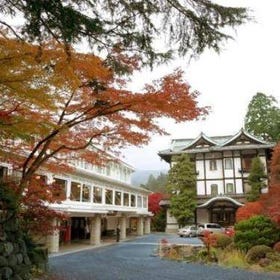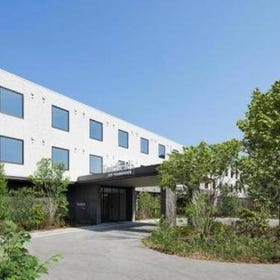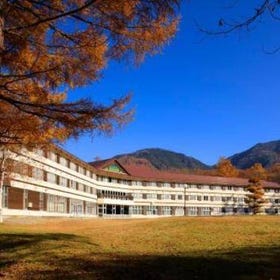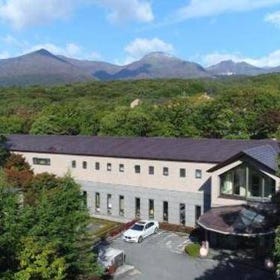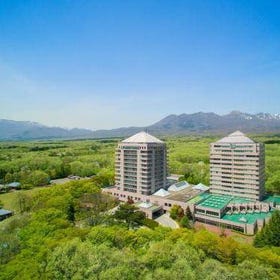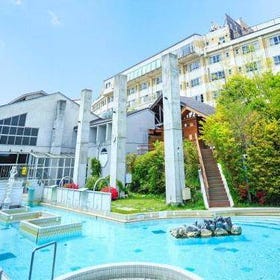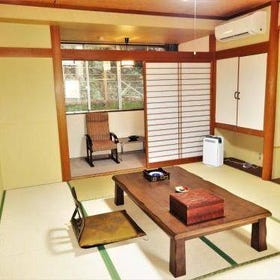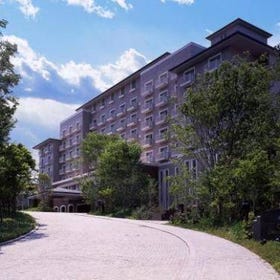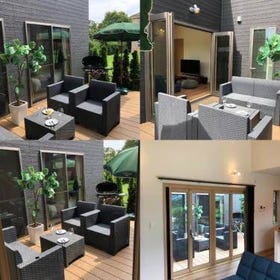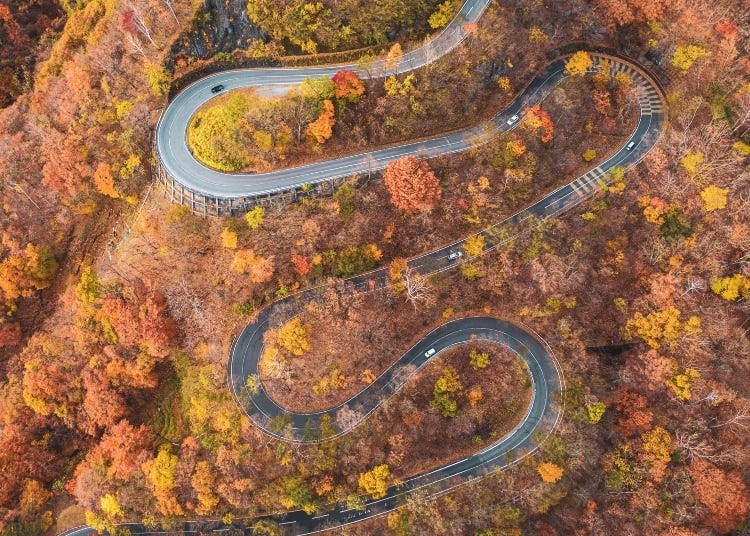
Japan has a special term for finding and admiring the best spots for autumn leaves that perfectly encapsulates the essence of this popular fall season leisure activity: momiji-gari, or autumn leaves-hunting!
This fun and exciting treasure hunt will take you across towns and prefectures as you scour the region for the most mesmerizing sights autumn offers.
Here, we'll share some of our favorite fall foliage road trips from Tokyo! From popular sightseeing hotspots to a lesser-known but equally beautiful site for autumn admiration, these three leaf-peeping areas in Kanto region suburbs are perfect for all you autumn foliage hunters.
They are perfect for enjoying over a weekend, starting with a relaxing drive from Tokyo. To make your trip even more convenient, we've included the MAP codes you can enter into your rental's navigation system.
* The exact period for autumn leaves differs from year to year.
1. Nikkō Area: A buffet of history, nature, and of course, beautiful fall leaves!
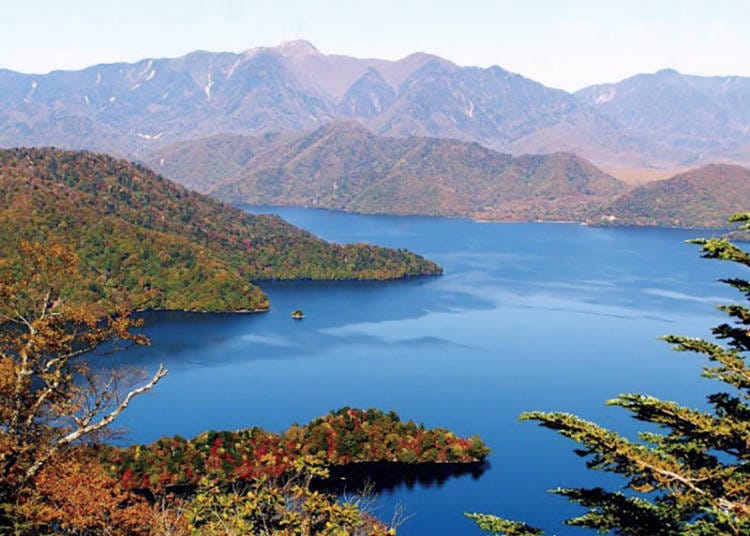
The Nikkō area in Tochigi, a prefecture north of Tokyo known for its rich history and abundance of natural sights, is our first recommendation.
This is where you can find, for example, the historic Nikkō Tōshō-gū, the representative building of the World Heritage Site known as Shrines and Temples of Nikkō.
This area never seems to run out of new things to discover, and this draws visitors from all over the world to bask in its beauty, no matter the season.
That said, autumn is one of the best seasons to visit Nikko because of its beautifully colored leaves. And it's convenient, too - because there are already countless viewing spots that have been set up especially for visitors to enjoy the fall foliage that will start showing up from late September to early November.
Getting to Nikkō

It takes about two hours by car or train to reach Nikkō from Tokyo, but we'd definitely recommend the drive!
Taking the train to Nikko is straightforward and recommended for people who would prefer to avoid metropolitan area traffic. If you decide on the train, the nearest stations to this area are Nikko Station on the JR Nikko Line or Tobu-Nikko Station on the Tobu Railway.
Rental car shops like 2525 Rental Car or Nissan Rental Car are available at each train station, so you can get to the best fall foliage spots with a shorter drive while still enjoying the experience.
1-1. Irohazaka Slope: Beautiful autumn leaves that can be admired from the comfort of your car seat
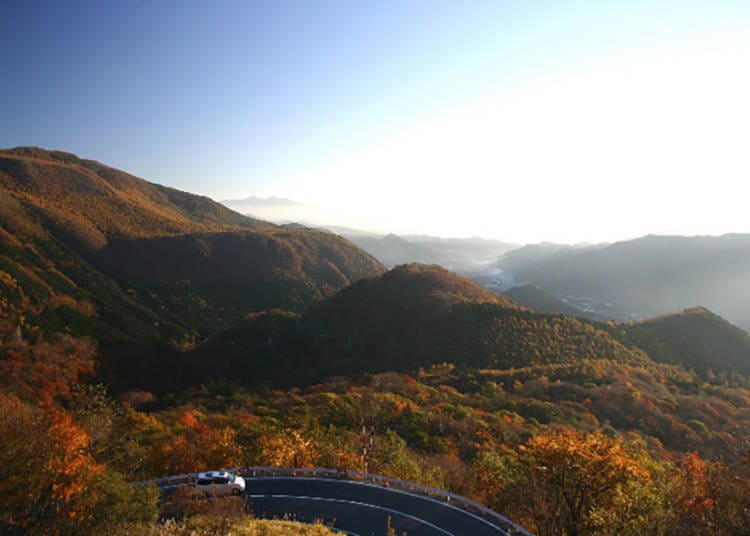
You can't say you've seen Nikkō's autumn leaves until you've been to Irohazaka Slope. This is a stretch of road that connects Nikkō City to Lake Chūzenji. The downhill part of the road is called Daiichi Irohazaka, and the uphill is known as Daini Irohazaka.
There are 48 curves on both roads, each named after a Japanese character. When you read the names of all 48 curves together, they form a classical Japanese poem known as "Iroha," hence the road's name - irohazaka (Iroha slope)!
Since this is a very well-known sightseeing spot for autumn leaves, you're likely to encounter traffic jams during peak season, so it may be wise to plan for that. The view from Akechidaira Ropeway Observation Deck on Daini Irohazaka is said to be exceptionally breathtaking.
The height difference typical of mountain roads gives the area a fresh new look every corner you turn, and that's a part of the area's charm as well, not to mention how fun it is to navigate through the sloping road with all its twists and turns!
Just a word of caution: Don't be too distracted by the amazing view out of the window and keep your eyes on the road at all times!
・Best time for viewing (typical season): Mid-October — Early November
・MAP Code: 367 242 093*50
-

-
Address
Chuguushi, Nikko-shi, Tochigi, 321-1661
View Map -
Nearest Station
Nikko Station (JR Nikko Line)
40 minutes by bus
-
Address
Chuguushi, Nikko-shi, Tochigi, 321-1661
1-2. Lake Chūzenji: Double the delight with fiery autumn leaves that reflect off the lake's calm waters!
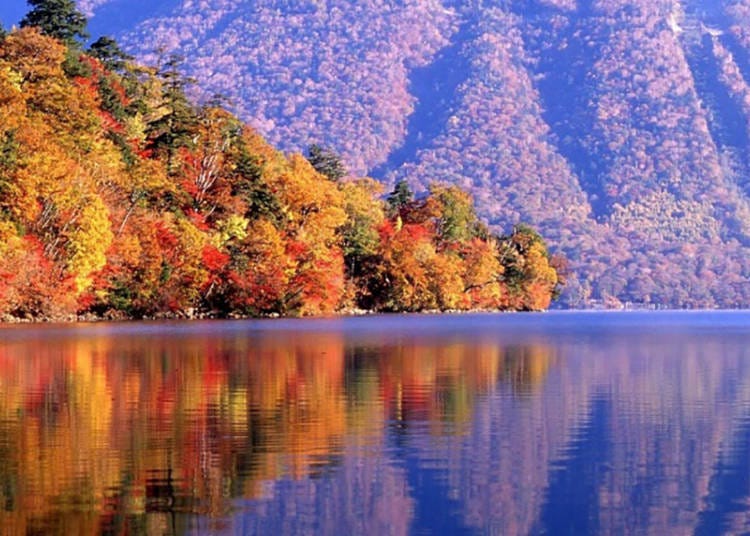
As you drive down Irohazaka Slope deeper into Nikkō, the large and majestic Lake Chūzenji starts coming into view. This beautiful body of water is a must-see spot for visitors to the Nikkō area, no matter the season!
At 1,269 meters (about 4,163 feet) above sea level, this is the most elevated lake in all of Japan. The unsullied and elegant atmosphere has made it a popular summer resort for foreigners since olden times and remains intact even now.
Mount Nantai is visible from the lake, and its autumn colors are a must-see when in season. Once you behold the sheer beauty of this scene, you may agree with many other visitors to the lake who insist it's like comfort food for the soul.
When the fall leaves are in full swing, there will be leisure boats taking eager tourists sightseeing around the best-known scenic spots - an activity you can also consider taking advantage of.
You'll have to park your car at a nearby carpark (charges apply) for a while, but the sights that await you are well worth the entry price!
・Best time for viewing (typical season): Mid-October — Early November
・MAP Code: 947 294 835*46
-

-
Address
Chuguushi, Nikko-shi, Tochigi, 321-1661
View Map -
Nearest Station
Nikko Station (JR Nikko Line)
-
Address
Chuguushi, Nikko-shi, Tochigi, 321-1661
1-3. Kirifuri Falls: One of the three most impressive waterfalls of Nikkō
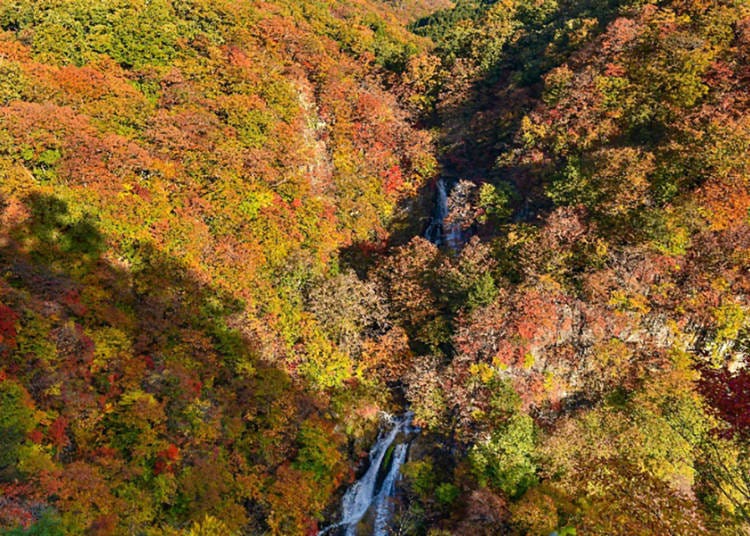
After enjoying a tour of Irohazaka Slope and Lake Chūzenji on the first day of your two-day Nikkō trip, head to Kirifuri Falls on the second day for yet another amazing experience.
Drive for about 10 minutes from Nikko Town to the waterfall's carpark (free of charge), then walk for about 10 minutes to get to the observatory deck.
Kirifuri Falls is known as one of the three most impressive waterfalls of Nikkō alongside Kegon Falls and Urami Falls - and for a good reason! Powerful rapids from the 75 meter-long (about 250 feet) Kirifuri River gush forward and fall over a two-tier platform, creating a dynamic scene that is both captivating and awe-inspiring.
The observatory deck is where you can catch sight of the rushing waterfall framed by a border of calmly swaying leaves proudly showing off their autumn clothing.
The contrast in both the colors and demeanor of both natural sights makes the entire scene surreal yet satisfying to the senses. The waterfall is also located near Kirifuri Plateau, a plain where plenty of valuable plants thrive.
If this appeals to the nature-lover in you, consider grabbing some gear and going on a leisurely hike at your own pace around the area while you're there!
・Best time for viewing (typical season): Late October — Early November
・MAP Code: 367 405 217*57
-
Kirifuri Falls霧降ノ滝
- Address Tokorono, Nikko-Shi, Tochigi 321-1421
-
Nearest Station
Access: Take the bus headed for Kirifuri Kogen or Ozasa Farm from Nikko Station on the JR Nikko Line or Tobu-Nikko Station on the Tobu-Nikko Line, stop at Kirifuri no Taki Bus Stop, and walk for about 15 minutes.
・Admission: Free
・Closed: Open daily
Recommended Places to Stay
These three lodging facilities come highly recommended by us to get the most out of your Nikkō trip, both for their convenient access to popular tourist hotspots and foreign language guest services support.
The first one is the historic Nikko Kanaya Hotel. There's also Fairfield by Marriott Tochigi Nikko, a stylish-looking building located in the midst of a peaceful natural environment. Finally, Nikko Astraea Hotel is situated right inside the Kōtoku Onsen area, and it features classic Japanese-style rooms for those who want to go all-out with cultural immersion!
Each hotel has unique characteristics that will appeal to visitors of all backgrounds.
2. Nasu Area: Magnificent views and exciting outdoor activities galore
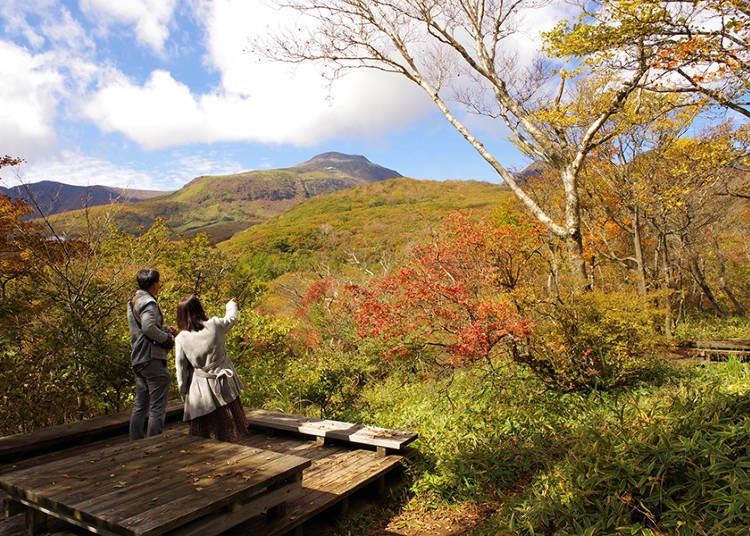
Our next recommended fall foliage road trip from Tokyo takes you to Tochigi Prefecture's Nasu area. It's about a 3.5-hour drive via expressway from Tokyo.
Many visitors associate Nasu with summer retreats or winter hot springs, but spending autumn here should absolutely be on the cards as well.
The combination of good weather and fantastic fall colors here makes it an excellent place for hiking and other outdoor activities too!
You can also take a gondola up the mountain to admire a panoramic view of the majestic and spacious region from a vantage point. We haven't even touched on the many interesting farms and art galleries to be explored in the region yet. Two days may not be enough to cover all the fun stuff that can be seen and done here!
Getting to Nasu

Hop on a Tohoku Shinkansen from Tokyo and get off at Nasushiobara Station on the JR Lines after about 1.5 hours.
Most of Nasu's main sightseeing hotspots can be reached within a 30-minute to 1-hour drive from this station, where you can rent a car from nearby shops like Eki Rental Cars or Nasukogen Car Rental. This is definitely the most convenient way to get around the best scenic sights this area has to offer.
- Nasushiobara Station on the JR Tohoku Line (Utsunomiya Line), JR Tohoku-Hokkaido Shinkansen Line
- Address: 561 Ōharama Nasushiobara, Tochigi 329-3153
MAP Code: 121 647 418*50
2-1. Momijidani Suspension Bridge: Feel the legendary "suspension bridge effect" while being surrounded in all directions by autumn leaves!
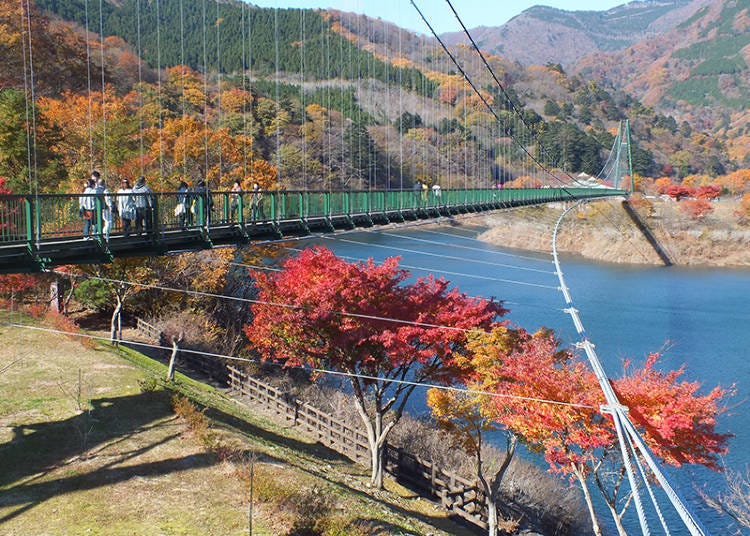
Your first stop should be the Momijidani Suspension Bridge, the longest suspension bridge in Japan at a length of about 320 meters (1,050 feet) that stretches over a vast and scenic valley.
Needless to say, it's one of the most popular places among visitors to the area all year round, but especially during autumn, when fiery fall foliage takes over the valley and brightens the place with its vibrant hues.
Fun fact: The bridge was recognized as a "Lover's Sanctuary" in April 2013, so it's wildly popular as a dating spot as well.
After you carefully make your way across the open bridge with your heart in your mouth, don't forget to take a commemorative picture at the mountain hawk-eagle monument on the other side with the gloriously autumn-tinted valley in the background!
・Best time for viewing (typical season): Late October - Early November
・Main types of trees: Japanese maple
・MAP Code: 121 720 207*41
-
Momijidani Suspension Bridgeもみじ谷大吊橋(森林の駅)
- Address 1425-60, Sekiya, Nasushiobara-Shi, Tochigi 329-2801
-
Nearest Station
Access: 20-minute drive from Tohoku Expressway's Nishinasuno IC.
30-minute by JR bus bound for Shiobara Onsen from Nishinasuo Station on the JR Lines. Get off at Momijidani Suspension Bridge Bus Stop or Mikaeribashi and walk for about 3 minutes.
・Phone: 0287-34-1037 (Reception time 9 AM–6 PM, excluding weekends, holidays, and end/start of year)
・Hours: (April 1–October 31) 8:30 AM–6 PM / (November 1–March 31) 8:30 AM–4 PM
・Fees: Adults 300 yen; Seniors 65+, elementary and middle school students 200 yen; Free parking
・Closed: Open daily
・Foreign language support: None
2-2. Mount Jeans Nasu: Lively view of autumn leaves all the way downslope - pet dogs are welcome too!
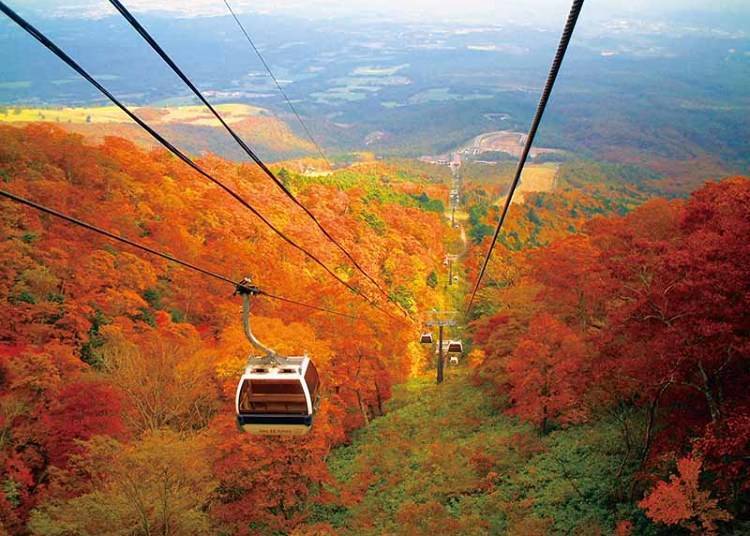
Mount Jeans Nasu is more well-known as a winter ski resort. Still, it's also a popular place for leaf peepers to visit in the Nasu area for its unique views of autumn leaves from the mountaintop, especially from the Chauso Observatory Deck.
You'll have to take the gondola to get up to the peak, and the view from inside the ride as it slowly ascends is a sight to behold as well. There are also walking and hiking routes for the adventurous or those wanting to enjoy the scenery at their own pace.
We highly recommend using one of these nature routes for at least one way to experience what autumn in Nasu offers fully!
There's a dog-run area (free entry) at the mountaintop for pet owners wanting to bond with their pups through outdoor activities, and the gondola is pet-friendly to that end, so feel free to bring your dog along for the ride!
The plaza at the mountaintop is family-friendly as well and comes installed with hammocks, slacklines, swings, and other playground equipment for all to have a good time.
・Best time for viewing (typical season): Early October — Early November
・Main types of trees: Quinquefolium azalea, Japanese maple
・MAP Code: 203 422 876*10
-
Mt. JEANS Nasuマウントジーンズ那須
- Address 966, Oshima, Nasu-Machi, Nasu-Gun, Tochigi 329-3223
-
Nearest Station
Access: About a 20-minute drive from Tohoku Expressway's Nasukogen Smart IC
- Phone Number 0287-77-2300
・Period: Saturday, September 18–Sunday, November 7
・Hours: Gondola 8:30 AM–3 PM (last ride down 3:30 PM); Dog run 8:30 AM–3 PM
・Gondola fee: (Round trip) Adults 1,700 yen; Minors (3–12) / Pets 900 yen; (One-way) Adults 1,400 yen; Minors (3–12) / Pets 700 yen
・Closed: Gondola open daily
・Foreign language support: Website supports five foreign languages
2-3. Nasu Heisei-no-Mori Forest: An educational nature tour awaits!
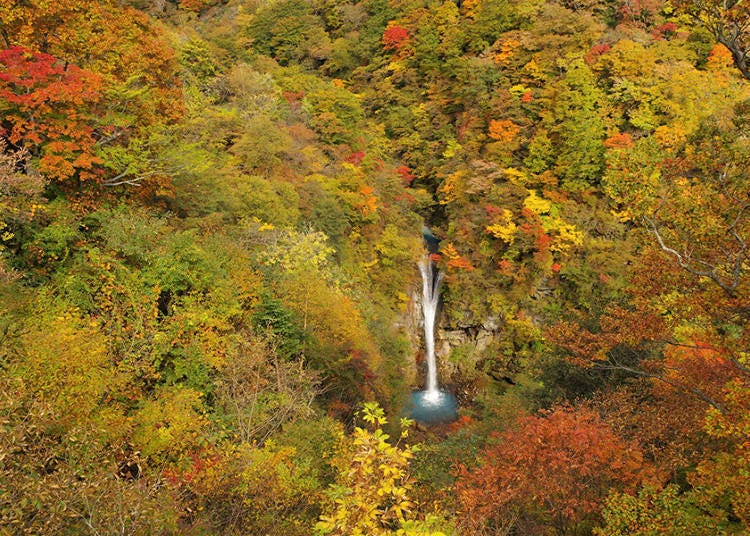
This peaceful forest is spread across the base of Nasu's many mountains. It has two main areas to explore: Fureai Forest for those wanting to experience nature in its unadulterated form and Manabi Forest, a guided walk designed to educate its participants.
Either way, you don't want to miss the Komadomeno Falls along the way for its spectacular view of red, yellow, and orange-tinted leaves during the autumn season.
The area was originally a part of the Nasu imperial villa grounds, so it stands to reason that it would be home to a fair number of rare plants. The field center staff are happy to take visitors around on a guided walk, and special programs will be held here from time to time as well, the content of which depends on the exact location and season of the event.
This allows you to learn something new about the area and its nature while admiring the autumn leaves - an invaluable experience highlighting how important it is for travelers to relish the journey as much as the destination!
Note that some programs require advanced reservations, so always check the official homepage for more information beforehand.
・Best time for viewing (typical season): Mid-October - Late October
・Main types of trees: More than ten types of Japanese maple, maple, azalea, beech, and others
・MAP Code: 203 391 708*86
-
Nasu Heisei-no-mori Forest Field Center日光国立公園 那須平成の森 フィールドセンター
- Address 3254, Takakuhei, Nasu-Machi, Nasu-Gun, Tochigi 325-0302
-
Nearest Station
Access: About 40-minute by car from Tohoku Expressway's Nasu IC or Nasukogen Smart IC
- Phone Number 0287-74-6808
・Hours: 9 AM–4:30 PM; May, August, October 9 AM–5 PM
・Admission: Free (charges apply for guided walks); Free parking
・Closed: Wednesdays (open if Wednesday falls on a holiday, closed the next day) *Also open during Golden Week, Obon, and the end/start of year holiday season
・Foreign language support: Some exhibits have English labels, English option on website
Recommended Places to Stay
Our top three picks for lodgings in Nasu will enhance your trip to the area for sure! Also, since Nasu is one of Japan's best regions for hot springs, you can't go wrong by including this feature when selecting the best accommodations for your group.
Blancvert Nasu certainly shines in this aspect for its close proximity to Nasu's spring sources, which allows it to be outfitted with a full suite of bathing facilities right inside the hotel itself. The building is also surrounded by calm and peaceful natural beauty, so it's really easy for guests to take their time here.
For those looking for something more active, try Hotel Epinard Nasu, a pet-friendly hotel that comes with facilities offering a wide range of activities and experiences.
Finally, Hotel Sunvalley Nasu is a spacious place with multiple lodging facilities that were individually designed with a different concept in mind. One of the highlights of this hotel is the dozens of bathing facilities and hot spring pools that guests can take advantage of during their stay.
3. Ōtaki / Kimitsu Area: Inner Bōsō and the incredibly pretty fall foliage within
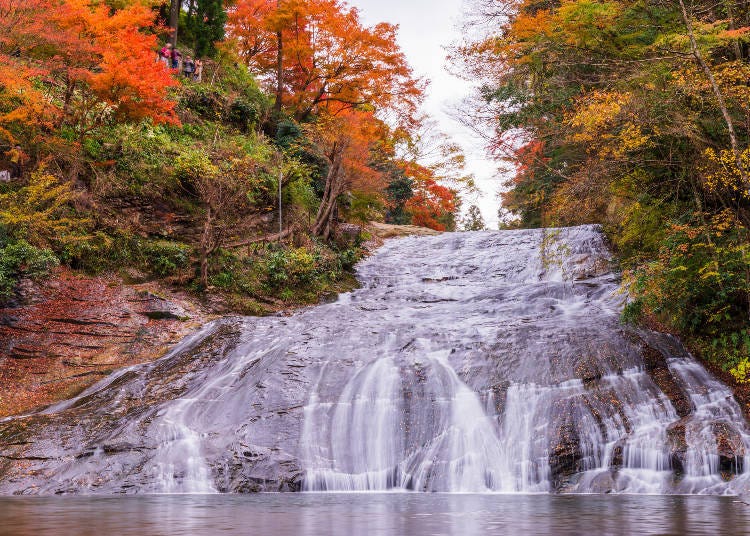
The last area on our recommended list is the Ōtaki / Kimitsu area, also known as one of the best places in Japan to see autumn leaves in their full glory. Located in the middle of Chiba Prefecture's Bōsō region, this place is chock-full of leisure and scenic spots featuring the mountains and sea.
The Yōrō Ravine in Ōtaki - which has its own hot spring resort, by the way - is especially rich with greenery. We think this is an ideal place to visit to immerse oneself in nature's pristine atmosphere.
The peak fall foliage period here starts a bit later than the Kanto region's usual mid-November to early December season, so those who missed out on the regular season for one reason or another should definitely consider making up for it by coming here!
Getting to Ōtaki / Kimitsu

The area is about a 1.5-hour drive via Tateyama Expressway or Aqua-Line boat ride from Tokyo. Either stop at Yorokeikoku Station on the Kominato Tetsudo to get to Yōrō Ravine or Kazusa-Kameyama Station on the Kururi Line to get to Kameyama Lake.
Meanwhile, you could also choose to stop at a larger terminal station that's a little bit farther and rent a car to drive to your destinations while taking in the sights along the way. In fact, this is what we'd recommend maximizing your time and enjoyment here.
To do this, take a bus from Tokyo or stop at Kisarazu Station on the JR Lines and rent a car from one of the nearby shops, such as 2525 Rental Cars and drive towards the Ōtaki / Kimitsu area from there.
- Kisarazu Station on the JR Uchibo Line and Kururi Line
- Address: 1-1 Fujimi, Kisarazu, Chiba 292-0831
MAP Code: 49 456 346*28
3-1. Awamata Waterfall (Yōrō Ravine): Natural beauty that heals the heart and soul!
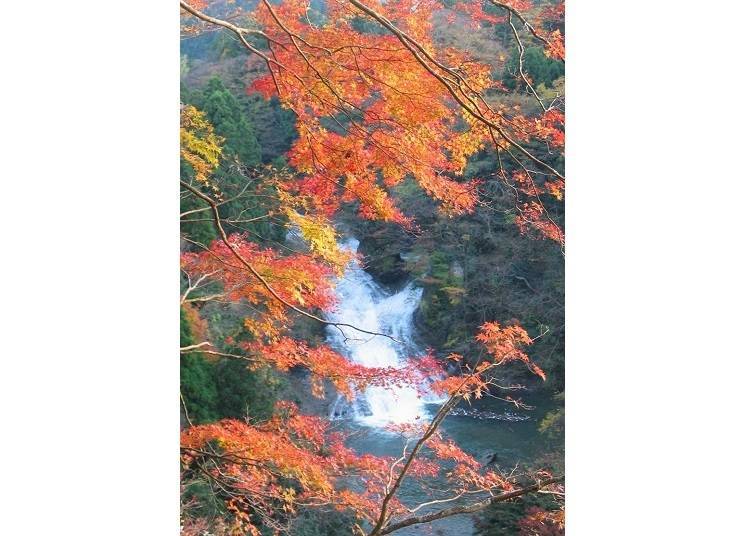
The area around Yōrō Ravine is one of the most popular places for spiritual healing one can find in Chiba and a lovely location to visit to see fantastic autumn leaves, especially during peak season when the entire valley seems to be ablaze with its fiery-looking foliage.
In recent years, more and more visitors have been going to Bōsō's well-known Awamata Waterfall to catch a glimpse of the falls surrounded by a border of deep red leaves during autumn.
During peak season, the waterfall is illuminated after sundown, and the lighting covers the area with a fantasy-like sheen that is itself another must-see sight of the region during autumn.
Arrange to have accommodations somewhere nearby, and you'll be able to enjoy this amazing nighttime collaboration between the waterfall and autumn leaves at leisure!
The waterfall falls from a height of about 100 meters (330 feet), and the thunderous momentum makes the entire scene quite exhilarating to watch. There's also a well-maintained recreation trail you can follow downstream along the Yōrō River from the waterfall basin for a relaxing walk through the area's rich and bountiful nature.
・Best time for viewing (typical season): Mid-November - Early December
・Main types of trees: Japanese maple, Chinese lacquer tree, beech, and others
・MAP Code: 309 772 788*73
Yōrō Ravine Autumn Leaves Illumination
・Where: Awamata Waterfall / Oikawa Crossroad / Nakase Trail / Others
・Period: Late November — Early December
・Time: 5:00 p.m. — 9:00 p.m.
-
Awamata Waterfall (Yoro Ravine)粟又の滝(養老渓谷)
- Address Awamata, Isumi-Gun, Otaki-Machi, Chiba 298-0277
-
Nearest Station
Access: About 23 km (14 miles) from Ken-o Expressway's Kisazaru-higashi IC via Tsukizaki.
About 20 km (12 miles) from Ken-o Expressway's Ichihara Tsurumai IC via Takataki Lake, Tabuchi.
About 36 km (22 miles) from Tateyama Expressway's Ichihara IC via Ushiku.
・Admission: Free, municipal parking fee for automobiles/light automobiles 500 yen
・Closed: Open daily
・Foreign language support: None
3-2. Tsutsumori Momiji Valley: Hidden gem only known to those in the know!

The autumn leaves of this secret little scenic spot are so striking, the entire valley vicinity looks like it's on fire during the peak autumn season. No wonder it was given the name "momiji" or "red leaf" valley!
This place is located relatively near to the Awamata Waterfall that was mentioned earlier. It's listed as one of the Eight Scenic Sights of Yōrō alongside such historic and cultural marvels as Shussei Kannon, Kannon Bridge, Kōbundō-ato, Kengaikyō, and others - a sterling testament to its beauty and significance.
The roads leading to this valley are narrow and hard to discern. It really is the definition of "off the beaten track"! You will, however, probably agree that all the effort put into locating the place was well worth it when the breathtaking sight it offers slowly unfolds as you approach the destination. This is a must-visit site in Ōtaki if you happen to be in the area.
* Please drive carefully as some roads in this area are too narrow to accommodate two vehicles side by side.
・Best time for viewing (typical season): Mid-November - Early December
・Main types of trees: Japanese maple, Chinese lacquer tree, beech, and others
・MAP Code: 309 768 828*14
-
Tsutsumori Momiji Valley筒森もみじ谷
- Address Tsutsumori, Otaki-Machi, Isumi-Gun, Chiba 298-0266
-
Nearest Station
Access: About 23 km (14 miles) from Ken-o Expressway's Kisazaru-higashi IC via Tsukizaki.
About 20 km (12 miles) from Ken-o Expressway's Ichihara Tsurumai IC via Takataki Lake, Tabuchi.
About 36 km (22 miles) from Tateyama Expressway's Ichihara IC via Ushiku.
・Hours: 24 hours
・Admission: Free, free parking at municipal carparks
・Closed: Open daily
・Foreign language support: None
3-3. Kameyama Lake: Hunting for the prettiest autumn leaves on top of a cruise ship
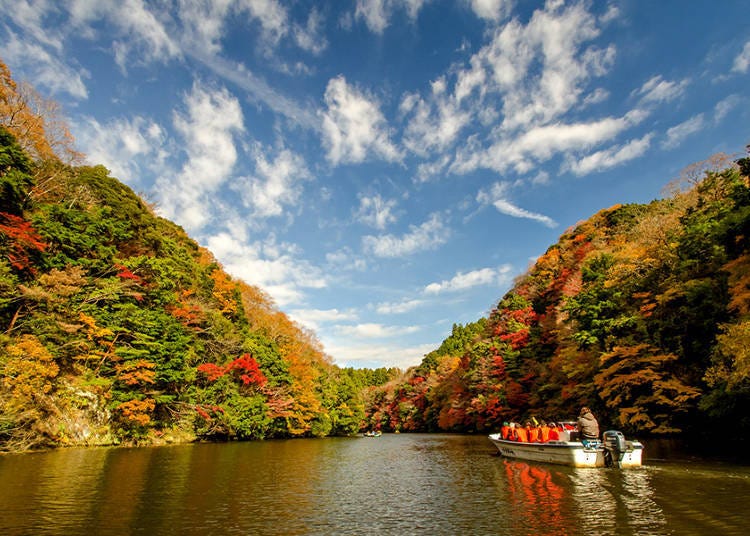
Kameyama Lake, about a 70-minute drive from Tokyo, is located in Chiba Prefecture's Kimitsu, an area known as the backyard of Bōsō Peninsula that is surrounded by amazing greenery and natural sights.
This is the largest dam lake within Chiba, and it's fully equipped with convenient facilities such as parks and nature trails nearby. Anyone can feel free to enjoy outdoor activities like fishing, cycling, or camping here during their visit.
We highly recommend checking out a couple of activities during fall foliage season: bridge-hopping and the momiji-gari lake cruise.
There are many bridges across Kameyama Lake that offer a unique angle to take pictures of the lovely autumn leaves. Finding the bridge that results in the best photo of the area may be a fun challenge to try!
Fishing boat shops around the lake will also be offering their own leaf peeking boat cruises during the season. Who better to show you the best autumn views than experienced fishermen who know the lake inside out, right?
What's more, some sceneries can only be seen from the viewpoint of a boat on the lake, so don't miss out on this opportunity to catch some rare shots to look back on fondly in the future!
・Best time for viewing (typical season): Mid-November - Early December
・Main types of trees: Japanese maple, ginkgo, oak, various mountain lacquer trees - mountains around Kameyama Lake will be completely covered with autumn leaves
・MAP Code: 309 790 802*73
-
Kameyama Lake亀山湖
- Address Kawamata Toyoda, Kimitsu-Shi, Chiba 292-0524
-
Nearest Station
Access: 30-minute drive from Ken-o Expressway's Kisazaru-higashi IC.
・Hours: 24 hours
・Admission: Free
・Closed: Open daily
・Foreign language support: None
Recommended Places to Stay
Finally, it's time to refresh yourself for the next day of adventuring, perhaps in one of these three comfortable lodgings.
If your focus of the trip is Yōrō Ravine and the area around it, Tenryū-sō in Yōrō Ravine's hot spring village comes highly recommended for its nearness to the ravine's scenic hotspots and how it uses fresh seasonal ingredients in its cuisine.
And the hot springs, of course! Okura Akademia Park Hotel in Kisarazu is for those of you more interested in the regions in the Uchibō area.
For the Sotobō area, definitely consider if KAI Ichinomiya in the town of Ichinomiya would suit your traveling needs.
Besides going on an autumn leaf hunting adventure, the Bōsō region is home to plenty of other sightseeing spots you can visit to have a good time as well, so you can use the second day of your itinerary to move around Uchibō and Sotobō for a more comprehensive tour of Chiba before leaving.
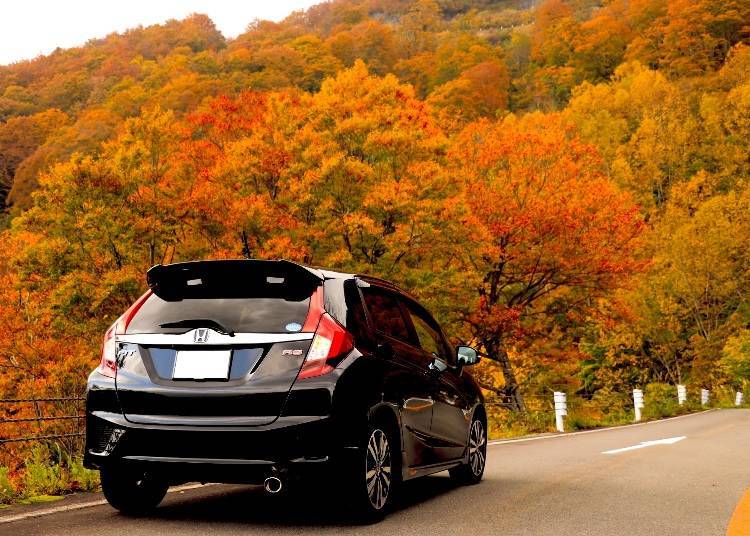
True, there are countless places within Tokyo itself where you can enjoy equally beautiful autumn sights as well, but it's always nice to spread your wings and try something new for a change once in a while.
Although slightly out of the way, Chiba's rich nature is a great complement to the region's fall foliage, and a two-day trip should be just the right amount of time needed to enjoy the places that interest you without needing to rush.
Are you ready to join a delightful fall foliage road trip from Tokyo? This autumn, enjoy hunting the right places to experience some of the best autumn leaves Japan has to offer!
* All prices stated in this article are inclusive of tax.
* Peak season for autumn leaves may change depending on weather, climate, and other factors.
Text by: Clink
English translation by: Huimin Pan
- Area
- Category
*Prices and options mentioned are subject to change.
*Unless stated otherwise, all prices include tax.
Recommended places for you
-

Stay with Snorlax? Grand Hyatt Tokyo's Summer Pokémon Resort Experience Is the Ultimate Sleepover
-

Japan Summer Sales 2025: Your Ultimate Guide to Shopping Deals In Tokyo, Kansai & More!
-

'They Do What in the Toilet?!' Italians Shocked By These Japanese Beauty Quirks
by: Yuu Sato
-

A Don Quijote Like No Other: Step Inside the All-New Tourist-Friendly Store at Shinjuku Tonanguchi Bekkan (Open June 13)
by: Chehui Peh
-

Hachiji juppun mae – A Japanese phrase that even Japanese people can’t agree on the meaning of
-

Police to ticket cyclists riding on sidewalks, which amounts to almost all cyclists in Japan
Inspiration for Accommodations
-

Enjoy Mt. Fuji from the Comfort of Your Room! Recommended Ryokan with Mt. Fuji View
-

Stay Near the Cherry Blossoms! Hotels for Cherry Blossom Viewing in Tokyo
-

Family-Friendly Hotels with Free Shuttle to Disneyland: Convenient Access for a Magical Stay
-

Top Ranked Hakone Hotels with Mt. Fuji View: Enjoy Stunning Scenery from Your Private Space
-

Convenient Tokyo Hotels with Airport Shuttle: Ideal for Families and Heavy Luggage
-

Stunning Tokyo Tower View Hotels: Enjoy Spectacular Scenery from Your Private Space
-

Convenient Asakusa Hotels with Kitchens: Ideal for Extended Family Visits
-

Experience Luxury: Hakone's 10 Best Five-Star Accommodations
-

Enjoy Mt. Fuji Autumn Leaves! Top Hotels Near the Popular Autumn Leaves Corridor
-

Experience Hakone Fall Foliage from Your Room with Stunning Views
-

Visiting Tokyo in September: Best of Autumn in Tokyo
by: Sohail Oz Ali
-

Autumn in Tokyo 2025: 16 Best Places to See Fall Foliage in Tokyo
-

16 Secrets About Mt. Fuji, the Symbol of Japan: Even Japanese People Don’t Know That?!
-

Enjoy Halloween in Japan 2024: Shibuya & Shinjuku Restrictions and Must-See Events Nationwide
by: Kaori Kimura
-

Atami 1-Day Itinerary: Exploring Japan's Castle & Hot Springs Resort Town Near Tokyo!
-

JR Edition: Visit all of Tokyo in one Day with the Tokyo Metropolitan District Pass!
- #best ramen tokyo
- #what to buy in ameyoko
- #what to bring to japan
- #new years in tokyo
- #best izakaya shinjuku
- #things to do tokyo
- #japanese nail trends
- #what to do in odaiba
- #onsen tattoo friendly tokyo
- #daiso
- #best sushi ginza
- #japanese convenience store snacks
- #best yakiniku shibuya
- #japanese fashion culture
- #best japanese soft drinks
















